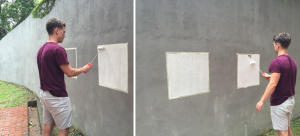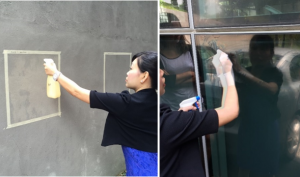Hydrophobic Coating
Good Practices
The positive characteristic of self-cleaning products will run out every two to four years and additional coatings are required.
Experiments have been conducted to demonstrate the effectiveness of hydrophobic surfaces as compared to other types of surfaces under extreme conditions.
A flow test done across the pipe coated with hydrophobic paint in its interior walls reveals that the water flow rate in the pipe increases proportionally with the increase in motor power of the variable speed pump at low speeds, which is similar to the control set-up with standard paint. However, after a certain flow rate, a marginal increase in pump power can produce a substantial increase in water flow rate across the pipe, indicating a drag reduction phenomenon. However, after more than 30 minutes, the drag phenomena had seemed to had disappear [23].
Another test conducted for anti-fouling revealed that prolonged exposure of hydrophobic surfaces in water of more than 2 days before exposing to air will destroy the structure and cause fouling on the surface similar to the normal paint. Moreover, having nanostructures on the surface that are less uniform in appearance characteristic also enhances the hydrophobic property [23].
Experiments have also shown that the water droplet flows faster on surfaces textured with super hydrophobic coats with characteristic texture sizes on the order of 10 µm as compared to coated un-textured surfaces under similar inclination [24].
Recent hydrophobic surfaces also are known to be effective against high temperature up to 200 degrees Celsius and they are able to withstand high humidity environment without losing its hydrophobic property [20].
Surface Preparation and Application
Self-cleaning paint
- Surface preparation
- Requirement: the substrate must be firm, dry, clean and load-bearing, as well as free from sinter layers, efflorescence agents. Damp or not fully cured substrates can lead to defects such as bubble formation or cracks in following layers.
- Preparations: check existing coatings for their load-bearing capacity. Remove any non-load-bearing or structurally weak coatings.
- Application
- Temperature: Lowest/highest temperature of substrate/air: +5 /+30 ℃.
- Material preparation: Intermediate coat diluted with max. 5% of water, finish diluted with 5% of water. Use as little water as possible to achieve application consistency. Stir well before application.
- Coating produce
- Substrate coating: depends on the type and condition of the substrate, a substrate coating of Sto-HydroGrund is generally recommended.
- Intermediate coat: StoColor Lotusan
- Finish: StoColor Lotusan
- Application: by paint brush, by roller, by airless spray-gun (Nozzle: 4/17 – 4/25; Pressure: 100 – 150 bar)
- Drying, curing, ready for next coat: high humidity and/or low temperature prolong drying. At +20 ℃ temperature (air and substrate) and 65% relative air humidity, it is over-coatable after approximately 8hrs.
The application of the lotus effect paint and the control surface with generic white paint was done using roller paint brushes.

Painting of self-cleaning paint
Nano Coatings
- Surface preparations
- Minimal condition before applications is to ensure all the surfaces (Glass, concrete, Aluminium) are cleaned without any foreign substances etc. on it. Recommended to clean extensively 1 day before application.
The surface substrates to be coated were thoroughly cleaned 24 hours before the application. A further thorough cleaning was done prior to application on the glass façade using heavy duty glass cleaner to remove residual alien material like dirt or bird poo.

Surface preparation done prior to application
- Nano Coat (on Concrete Building substrate):
- Ensure the substrate to be clean, firm and dry, diluted the product in IPA at the ratio of 30:70
- Apply with paint brush, roller or a sprayer (limited pressure: 10 psi).
- Interval between coats: 1 hour.
- Nano Invisible Coat (on metal substrate):
- Ensure the substrate is free of dirt, oil, tar or grease. Use IPA glass cleaner to remove any polish residue or grease.
- Applying with 1.0mm nozzle spray gun.
- 2 layers, apply 2nd coat when the 1st coat is dry.
- Nano Glass Coat:
- Thoroughly clean required, ensure the substrate is free of dirt, oil, tar or grease.
- Spray the product onto the substrate, 1 coat, clean the sprayed area after 24hrs.

Application of coating on different substrates
Implications
Hydrophobic coatings are mostly used in applications that are not prone to wear and tear such as electronic components. Objects subject to constant friction like boats hulls would require constant re-application of such a coating to maintain a high degree of performance.
The hydrophobic coatings’ fine particles that are being rubbed off can pose biological hazards to both human beings and animals. Certain types of chemicals used in making of hydrophobic paint are known to be toxic to humans and the environment. For instance, silica, in its crystalline form, is a human lung carcinogen [21]. TiO2 can induce pathological lesions of the liver, spleen, kidneys, and brain [22].
There are currently no reviews on any form of chemical reactions of the existing facade to the paint or sealant after application, but generally hydrophobic paints cannot be applied on other coating surfaces, especially thermoplastic properties.